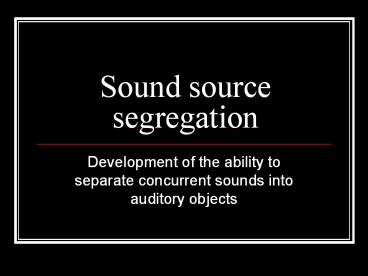Sound source segregation - PowerPoint PPT Presentation
Title:
Sound source segregation
Description:
Sound source segregation. Development of the ability to separate concurrent ... Diotic = 2 ears, same sound in both (0) Dichotic = 2 ears, different sound in each (p) ... – PowerPoint PPT presentation
Number of Views:143
Avg rating:3.0/5.0
Title: Sound source segregation
1
Sound source segregation
- Development of the ability to separate concurrent
sounds into auditory objects
2
The problem
Wow! Psychophysics is interesting!
TIME
FREQUENCY
3
Cues that adults use to segregate components into
sources
- Spectral separation
- Spectral profile
- Harmonicity
- Spatial separation
- Temporal separation
- Temporal onsets and offsets
- Temporal modulations
4
Measuring sound source segregation
- Auditory streaming
- Thresholds of sounds, segregated and not
segregated - Informational masking (indirect evidence)
5
Auditory streaming
6
A single sound source is perceived
7
Two sound sources are perceived
8
Auditory streaming in infants
How many streams that time?
9
Auditory streaming in infants
10
Auditory streaming in infants
Configuration 3/1
Configuration 2/2
11
Electrophysiological measures of streaming in
newborns
12
(No Transcript)
13
Auditory streaming in children
14
Auditory streaming in children
15
Another way to look at auditory streaming in
children
16
Electrophysiological measures of streaming in
children
Electrophysiological measures of streaming in
children
17
Conclusion
- Infants and children form auditory streams.
18
Thresholds of sound, segregated and not segregated
- Spatial cues
- Synchronized visual information
19
Masking level difference
The MLD is the improvement in audibility that
results from dichotic listening
N noise, S signal Monotic one ear
(m) Diotic 2 ears, same sound in both
(0) Dichotic 2 ears, different sound in each
(p)
Modified from Gelfand (1998)
20
MLD in infants
21
MLD in children
22
Spatial unmasking
(noise)
Baseball
(noise)
23
Spatial unmasking in preschool children
24
Spatial unmasking in school-age children
25
Preferential looking procedure
baseball, baseball, baseball
popcorn, popcorn, popcorn
baseball, baseball, baseball
(Twenty subjects were tested)
26
Speech in speech recognition in infants
27
Visual information improves speech in speech
recognition in infants
28
Testing whether children can segregate speech
from speech
Ready Baron go to Blue 3 now Ready Ringo go to
Red 5 now
29
Visual information doesnt improve speech in
speech recognition in children
30
Conclusions
- Infants and children are more sensitive to sounds
that can be segregated from competing sounds,
although infants show less benefit of segregation
cues. - Under simple conditions, even 3-year-olds can use
segregation cues as well as adults. - Under complex conditions, even 10-year-olds do
not use segregation cues as well as adults.
31
Informational masking
Interval 1
Interval 2
Trial
1
Level
2
3
Frequency
32
Informational masking in children
33
Informational masking in infants
34
Information masking in infants
35
Fixed, remote frequency masking in children
36
Informational masking?
Interval 1
Interval 2
Trial
1
Level
2
3
Frequency
37
Using temporal cues to reduce informational
masking
38
Summary and conclusions
- Infants and children can segregate sound sources,
using the same acoustic cues that adults use. - In simple situations, children, but not infants,
can segregate sound sources as well as adults. - In complex situations, sound source segregation
may not be mature until well into the school
years.

